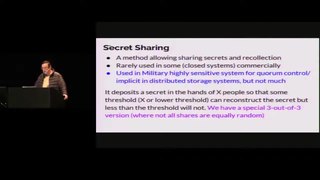A cypherpunk is any individual advocating widespread use of strong cryptography and privacy-enhancing technologies as a route to social and political change. Originally communicating through the Cypherpunks electronic mailing list, informal groups aimed to achieve privacy and security through proactive use of cryptography. Cypherpunks have been engaged in an active movement since at least the late 1980s and early 1990s.
Articles related to cryptography include:

David Lee Chaum is an American computer scientist, cryptographer, and inventor. He is known as a pioneer in cryptography and privacy-preserving technologies, and widely recognized as the inventor of digital cash. His 1982 dissertation "Computer Systems Established, Maintained, and Trusted by Mutually Suspicious Groups" is the first known proposal for a blockchain protocol. Complete with the code to implement the protocol, Chaum's dissertation proposed all but one element of the blockchain later detailed in the Bitcoin whitepaper. He has been referred to as "the father of online anonymity", and "the godfather of cryptocurrency".

RSA Security LLC, formerly RSA Security, Inc. and trade name RSA, is an American computer and network security company with a focus on encryption and encryption standards. RSA was named after the initials of its co-founders, Ron Rivest, Adi Shamir and Leonard Adleman, after whom the RSA public key cryptography algorithm was also named. Among its products is the SecurID authentication token. The BSAFE cryptography libraries were also initially owned by RSA. RSA is known for incorporating backdoors developed by the NSA in its products. It also organizes the annual RSA Conference, an information security conference.
In cryptography, a zero-knowledge proof is a protocol in which one party can convince another party that some given statement is true, without conveying to the verifier any information beyond the mere fact of that statement's truth. The intuition underlying zero-knowledge proofs is that it is trivial to prove possession of the relevant information simply by revealing it; the hard part is to prove this possession without revealing this information.

Adam Back is a British cryptographer and cypherpunk. He is the CEO of Blockstream, which he co-founded in 2014. He invented Hashcash, which is used in the Bitcoin mining process.
Dual_EC_DRBG is an algorithm that was presented as a cryptographically secure pseudorandom number generator (CSPRNG) using methods in elliptic curve cryptography. Despite wide public criticism, including the public identification of the possibility that the National Security Agency put a backdoor into a recommended implementation, it was, for seven years, one of four CSPRNGs standardized in NIST SP 800-90A as originally published circa June 2006, until it was withdrawn in 2014.

Mordechai M. "Moti" Yung is a cryptographer and computer scientist known for his work on cryptovirology and kleptography.
Zerocoin is a privacy protocol proposed in 2013 by Johns Hopkins University professor Matthew D. Green and his graduate students, Ian Miers and Christina Garman. It was designed as an extension to the Bitcoin protocol that would improve Bitcoin transactions' anonymity by having coin-mixing capabilities natively built into the protocol. Zerocoin is not currently compatible with Bitcoin.

Bullrun is a clandestine, highly classified program to crack encryption of online communications and data, which is run by the United States National Security Agency (NSA). The British Government Communications Headquarters (GCHQ) has a similar program codenamed Edgehill. According to the Bullrun classification guide published by The Guardian, the program uses multiple methods including computer network exploitation, interdiction, industry relationships, collaboration with other intelligence community entities, and advanced mathematical techniques.
Dell BSAFE, formerly known as RSA BSAFE, is a FIPS 140-2 validated cryptography library, available in both C and Java. BSAFE was initially created by RSA Security, which was purchased by EMC and then, in turn, by Dell. When Dell sold the RSA business to Symphony Technology Group in 2020, Dell elected to retain the BSAFE product line. BSAFE was one of the most common encryption toolkits before the RSA patent expired in September 2000. It also contained implementations of the RCx ciphers, with the most common one being RC4. From 2004 to 2013 the default random number generator in the library was a NIST-approved RNG standard, widely known to be insecure from at least 2006, containing a kleptographic backdoor from the American National Security Agency (NSA), as part of its secret Bullrun program. In 2013 Reuters revealed that RSA had received a payment of $10 million to set the compromised algorithm as the default option. The RNG standard was subsequently withdrawn in 2014, and the RNG removed from BSAFE beginning in 2015.
The tables below compare cryptography libraries that deal with cryptography algorithms and have application programming interface (API) function calls to each of the supported features.

Attempts, unofficially dubbed the "Crypto Wars", have been made by the United States (US) and allied governments to limit the public's and foreign nations' access to cryptography strong enough to thwart decryption by national intelligence agencies, especially the National Security Agency (NSA).
FREAK is a security exploit of a cryptographic weakness in the SSL/TLS protocols introduced decades earlier for compliance with U.S. cryptography export regulations. These involved limiting exportable software to use only public key pairs with RSA moduli of 512 bits or fewer, with the intention of allowing them to be broken easily by the National Security Agency (NSA), but not by other organizations with lesser computing resources. However, by the early 2010s, increases in computing power meant that they could be broken by anyone with access to relatively modest computing resources using the well-known Number Field Sieve algorithm, using as little as $100 of cloud computing services. Combined with the ability of a man-in-the-middle attack to manipulate the initial cipher suite negotiation between the endpoints in the connection and the fact that the finished hash only depended on the master secret, this meant that a man-in-the-middle attack with only a modest amount of computation could break the security of any website that allowed the use of 512-bit export-grade keys. While the exploit was only discovered in 2015, its underlying vulnerabilities had been present for many years, dating back to the 1990s.
Monero is a cryptocurrency which uses a blockchain with privacy-enhancing technologies to obfuscate transactions to achieve anonymity and fungibility. Observers cannot decipher addresses trading Monero, transaction amounts, address balances, or transaction histories.
Wei Dai is a computer engineer known for contributions to cryptography and cryptocurrencies. He developed the Crypto++ cryptographic library, created the b-money cryptocurrency system, and co-proposed the VMAC message authentication algorithm.

Zcash is a privacy-focused cryptocurrency which is based on Bitcoin's codebase. It shares many similarities, such as a fixed total supply of 21 million units.

Firo, formerly known as Zcoin, is a cryptocurrency aimed at using cryptography to provide better privacy for its users compared to other cryptocurrencies such as Bitcoin.
A cryptocurrency wallet is a device, physical medium, program or an online service which stores the public and/or private keys for cryptocurrency transactions. In addition to this basic function of storing the keys, a cryptocurrency wallet more often offers the functionality of encrypting and/or signing information. Signing can for example result in executing a smart contract, a cryptocurrency transaction, identification, or legally signing a 'document'.

George Danezis, FBCS is a computer scientist and Professor of Security and Privacy Engineering at the Department of Computer Science, University College London where he is part of the Information Security Research Group, and a fellow at the Alan Turing Institute. He co-founded Chainspace, a sharded smart contract platform, and was Head of Research before it was acquired by Facebook. After leaving Facebook he co-founded MystenLabs and is one of the designers of the Sui Blockchain. He currently works part-time as a Professor at University College London and as Chief Scientist at MystenLabs.









